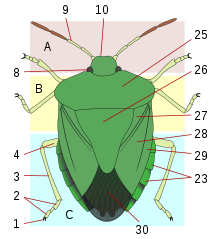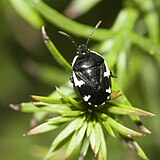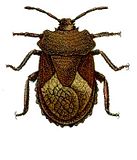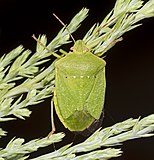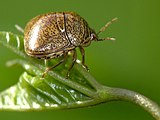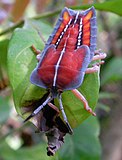
Pentatomidae is a family of insects belonging to the order Hemiptera, generally called shield bugs or stink bugs. Pentatomidae is the largest family in the superfamily Pentatomoidea, and contains around 900 genera and over 4700 species. As hemipterans, the pentatomids have piercing sucking mouthparts, and most are phytophagous, including several species which are severe pests on agricultural crops. However, some species, particularly in the subfamily Asopinae, are predatory and may be considered beneficial.

Scutelleridae is a family of true bugs. They are commonly known as jewel bugs or metallic shield bugs due to their often brilliant coloration. With the name based on the Asian genus Scutellera, they are also known as shield-backed bugs due to the enlargement of the thoracic scutellum into a continuous shield over the abdomen and wings. This latter characteristic distinguishes them from most other families within Heteroptera, and may lead to misidentification as a beetle rather than a bug. These insects feed on plant juices from a variety of different species, including some commercial crops. Closely related to stink bugs, they may also produce an offensive odour when disturbed. There are around 450 species worldwide.

The Pentatomomorpha comprise an infraorder of insects in the true bug order Hemiptera. It unites such animals as the stink bugs (Pentatomidae), flat bugs (Aradidae), seed bugs, etc. They are closely related to the Cimicomorpha.

Acanthosomatidae is a family of Hemiptera, commonly named "shield bugs" or "stink bugs". Kumar in his 1974 world revision recognized 47 genera; now this number is 55 genera, with about 200 species, and it is one of the least diverse families within Pentatomoidea. The Acanthosomatidae species are found throughout the world, being most abundant in high-latitude temperate regions and in subtropical regions at high altitudes.

Tessaratomidae is a family of true bugs. It contains about 240 species of large bugs divided into 3 subfamilies and 56 genera.

Urostylididae is a family of true bugs and is considered a basal or "primitive" family within the stink-bug lineage. They are found only in Asia. Older works used the spelling Urostylidae but this clashes with the name used for a protozoan family and a spelling correction (emendation) has been suggested that also avoids the confusion created by homonyms. The family name Urolabididae has also been used for some members in the past.

Perillus is a genus of predatory stink bugs in the family Pentatomidae. There are about seven described species in Perillus.
Vulsirea nigrorubra is a species of stink bug in the family Pentatomidae. It is found in the Caribbean.

Mormidea lugens is a species of stink bug in the family Pentatomidae found in the Caribbean, Central America, and Eastern North America. In Illinois, adults have been observed emerging from overwintering sites in late April, and continue to be observed until early November, and appear to be bivoltine in this area. Eggs are approximately 0.7 millimetres (0.028 in) in diameter, pale yellow, and laid in small clusters of 6 to 11 eggs. Adults are bronze in color, with a white-yellow border around the scutellum, and are 5.0–7.2 millimetres (0.20–0.28 in) in length. In laboratory conditions, at approximately 24 °C (75 °F), development from eggs to adults has been documented to take between 39 and 50 days, and appears to be affected by the species of host plant. Mormidea lugens has been documented to feed on timothy, sedges, as well as deer-tongue grass, and Bosc's panic-grass. It has been collected from pale sedge and wide-leaved spiderwort but has not observed feeding on these species, and deer-tongue grass appears to be an insufficient food source for development.
Sciocoris longifrons is a species of stink bug in the family Pentatomidae. It is found in North America.
Weda is a genus of turtle bugs in the family Pentatomidae. There are at least three described species in Weda.

Mormidea is a genus of stink bugs in the family Pentatomidae. There are about five described species in Mormidea.
Vulsirea is a genus of stink bugs in the family Pentatomidae. There are at least two described species in Vulsirea.
Banasa lenticularis is a species of stink bug in the family Pentatomidae. It is found in the Caribbean, Central America, North America, and South America.

Chlorocoris hebetatus is a species of stink bug in the family Pentatomidae. It is found in Central America and North America.

Chlorocoris is a genus of stink bugs in the family Pentatomidae. There are about six described species in Chlorocoris.

Oebalus ypsilongriseus is a species of stink bug in the family Pentatomidae. It is native to South America, where it is known to feed on rice crops, as well as cotton, barley, oat, and wheat.

Oebalus is a genus of stink bugs in the family Pentatomidae. There are about six described species in Oebalus.

Mecideini is a tribe of stink bugs in the family Pentatomidae. There is at least one genus, Mecidea, in Mecideini.
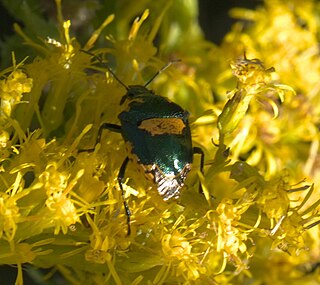
Stiretrus anchorago, commonly known as the anchor stink bug, is a species of predatory stink bug in the family Pentatomidae. It is found in Central America and North America. It is known to prey upon Epilachna varivestis and Hypera postica.

